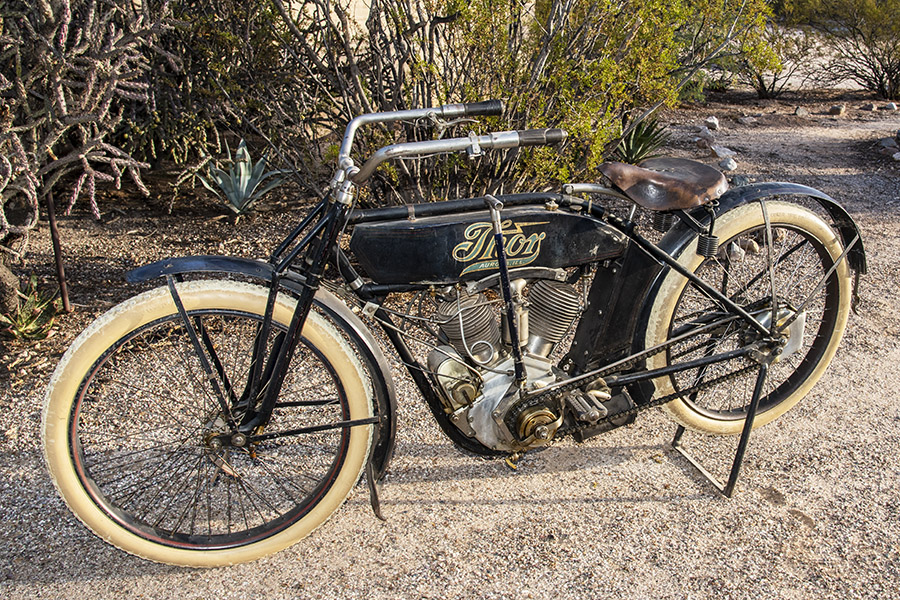By Joe Berk
Susie and I recently visited the Franklin Automobile Museum in Tucson, Arizona, and while we were there I photographed their 1913 Thor Model U motorcycle. It’s a fascinating machine from many perspectives, one of which is what those guys had to do back in the day to start their motorcycles. Today, we have electric starters and fuel injection…hit the ignition, touch the starter button, and go. Turn back the clock 15 years or so and it was open the fuel petcock, close the choke, turn on the ignition, and hit the starter button. Turn back the clock 50 or 70 years and you have to add kickstarting to the mix. Go back a century or more (for this 1913 Thor, it would be a cool 110 years), and wow, you practically had to go to Thor University to learn the drill.
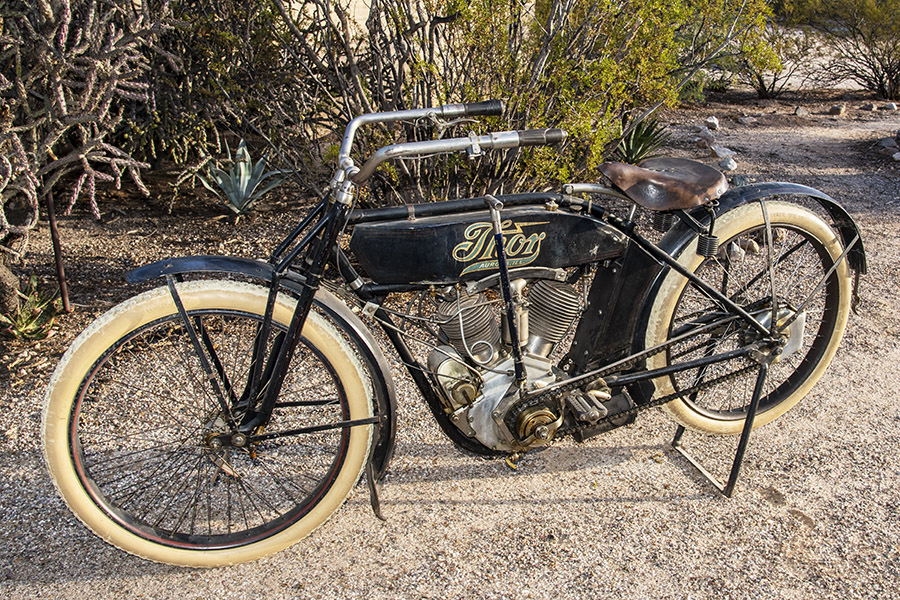
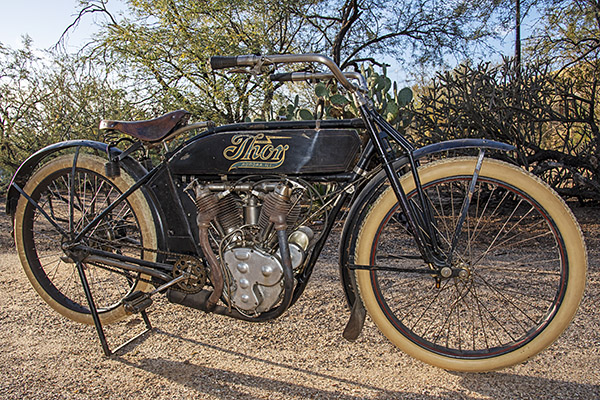
Starting a Thor would keep a rider busy. The bike had to be on its rear wheel centerstand to get the rear wheel off the ground (why will become clear in a bit). Then you had to put the engine in gear by pushing the clutch lever forward. You might think that’s counter-intuitive. Read on, blog acficionados.
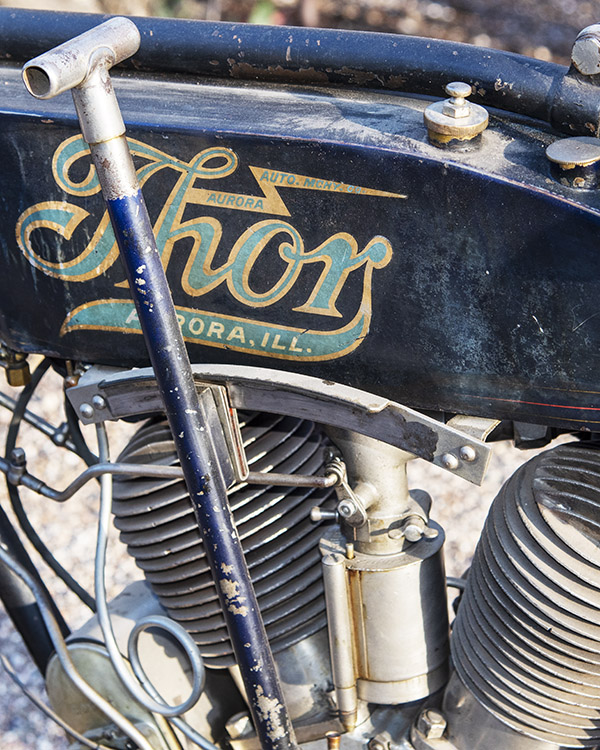
If your Thor had the the optional two speed rear hub transmission (a $40 option on top of the motorcycle’s $290 price in 1913), you would want to make sure it was in the high gear position. You do that by turning the T-handle on top of the clutch lever parallel to the motorcycle. Having the bike in second gear would make the engine easier to turn over; it would be like putting your bike in second for a run-and-bump start (and I realize as I type this how few readers will know what a run-and-bump start is). But we’re not going to run-and-bump this priceless 1913 Thor. Stay with me; this is going to get interesting.
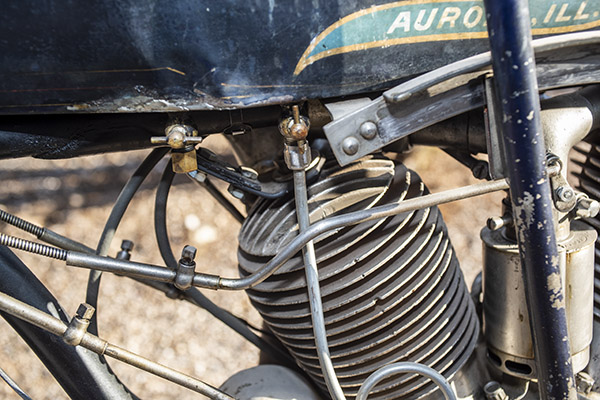
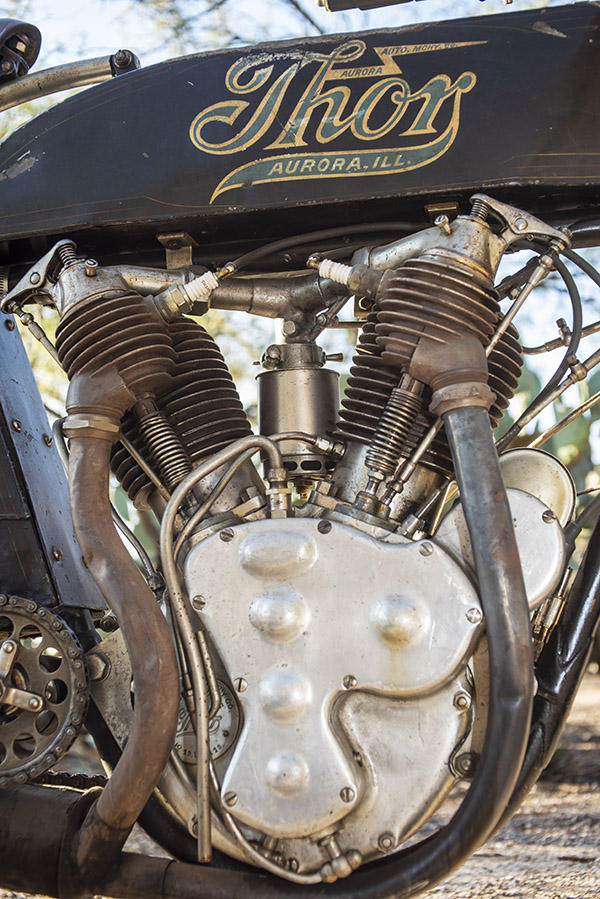
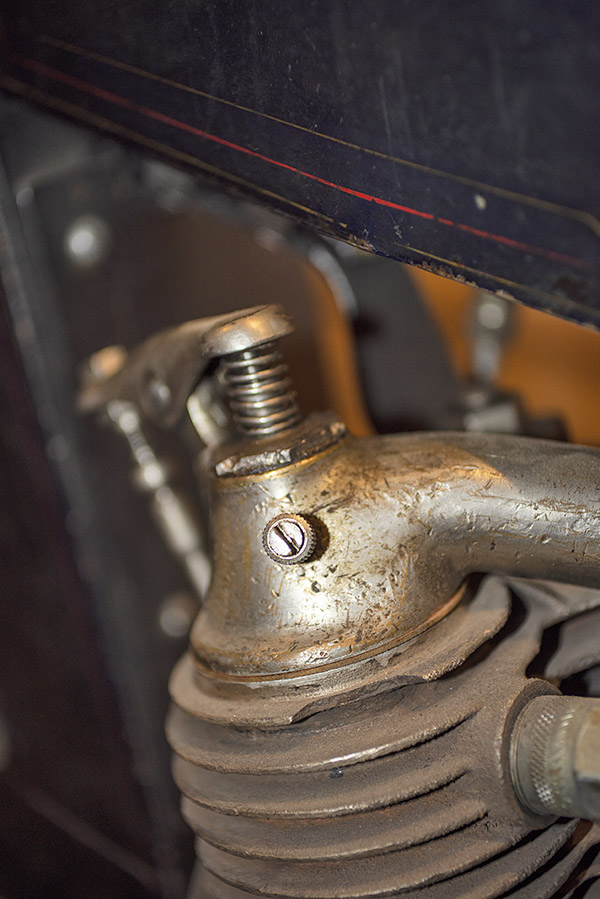
Next up: Prime the engine by taking a bit of fuel from the Thor’s fuel tank priming petcock and manually inject gasolina into the intake cups (the Thor has openings in its intake domes for this purpose…those Thor engineers thought of everything). Or, you could use the optional device on top of the fuel filler cap to extract a bit of fuel. Like I said, they thought of everything.
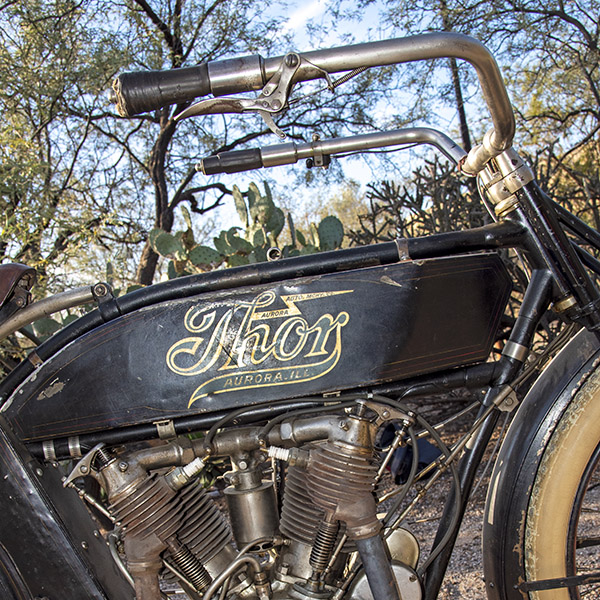
You then retard the ignition timing via the right twistgrip (you read that right; the left twistgrip works the throttle) by twisting it clockwise. Having the ignition fire after top dead center, you see, makes it easier for the engine to catch a spark and continue running. So where’s the throttle? That’s on left handlebar. Open the left twistgrip a bit by turning it clockwise. It will stay where you leave it; there’s no return spring.
That funny little chrome lever on the right handlebar? It’s not a clutch (remember, that was ginormous lever to the left of the fuel tank). The little right-handlebar-mounted lever is a compression release. Pull it in, and it opens the exhaust valves to, well, release the compression. It makes it easier to pedal, and we’ll get to that momentarily. Maybe you didn’t believe me when I told you this was a complicated undertaking. Read on. It gets even more interesting.
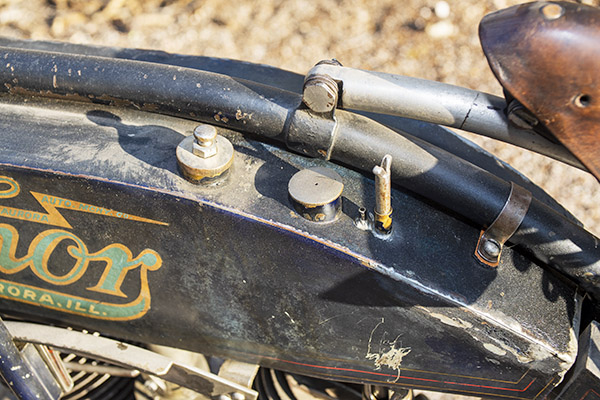
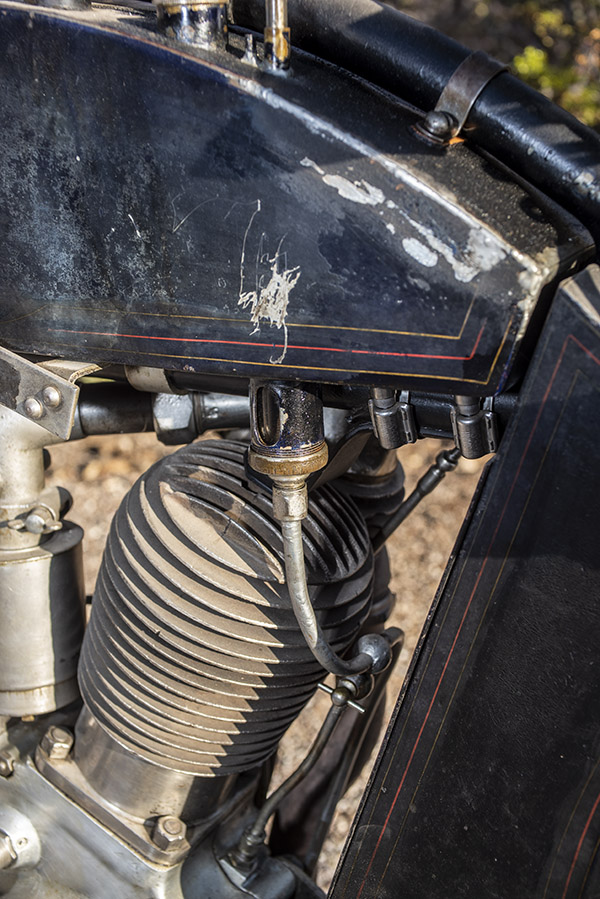
The Thor has a total loss lubrication system. That term, total loss, doesn’t describe how your 401K account is doing these days; it refers to how the engine uses oil. It uses and consumes it (it’s not returned or recirculated). Think of it as Autolube for four strokes. Ah, shoot, I’ll bet a lot of you are too young to know what Autolube is, too. Gresh can explain it later. Back to the main attraction, that total loss lubrication system…there’s an oil petcock halfway down the oil line on the left side of the motorcycle, between the sight glass and the crankcase. It needs to be open (you may void your warranty if operate the motorcycle with it closed). The Thor would consume a quart of oil every 50 to 300 miles depending on conditions and your riding style, but the tank carried a gallon, and with a top speed somewhere between 50 and 65 mph (again, depending on conditions, the rider, and whether or not you had the optional two speed transmission), it’s not likely you would run out of oil. “They smoke a lot,” one Thor expert told me, “so as long as you see blue smoke behind you, you’re good.”
The last bit of preparation involved closing the choke on that big tomato can Thor carb nestled in the V between the cylinders, and that involved two actions: Closing a thumbscew on the carb’s rear and screwing down a tapered knob on top.
All right…now we’re ready to get to the good part. You may have noticed that the Thor has two chains (one on each side of the motorcycle) and a set of pedals (like a bicycle). Once you have completed all the actions described above, you can get on the Thor and start pedaling like Lance Armstrong charging up the Col du Tourmalet (I say that figuratively; the good guys at the Franklin Automobile Museum are not going to let you climb onto their 1913 Thor). Your pedaling is going to drive the rear wheel via the chain on the right side of the motorcycle from the pedals’ chainring to the rear wheel sprocket. That’s going to spin the rear wheel and tire (which is why we wanted the bike on its centerstand), transmit the rotational inertia you generated through the rear-hub-mounted transmission, turn the drive chain on the left side of motorcycle, transmit your torque through the clutch (which we engaged earlier) and spin the Thor’s 61-cubic-inch V-twin. As you ponder all of that, be thankful that you’re not trying to crank the 1914 Thor’s larger 74-cubic-inch engine, and be thankful that I clued you into actuating the compression release. And finally, be thankful that you’re adding the rear wheel and tire’s flywheel effect to what you (the motive force in this cacaphony of early American motorcycle starting activities) have set in motion.
Once you’ve attained sufficient rotational inertia, release the right handlebar compression release. If Thor and the other ancient Norse gods are smiling, the engine will catch, and you’ll hear the opening chords of that delightful “potato-potato-potato” V-twin symphony we Americans love. As soon as you are sure the music will continue, pull that large left clutch lever rearward to disengage the clutch and reverse direction on the pedals (like you would have on the Schwinn you rode as a kid). As mentioned earlier, there’s a coaster brake back there; in fact, it’s the only brake on this motorcycle. While the engine is warming up, advance the ignition (with the right twistgrip), open the carb choke (it involves two actions, as mentioned above), and then, as the owner’s manual explains with early American Aurora engineering precision, apply “a trifle” of throttle (with the left twistgrip). The owner’s manual authors’ descendants, I’m sure, went on to become writers for Saturday Night Live in the early days when that show was still funny. One more thing…if it’s a cold day, Thor recommended placing a rag soaked in warm water around the carburetor’s float chamber.
Once everything is percolating to your satisfaction, roll the motorcycle forward off the stand (Pro Tip: Remember to disengage the clutch first), and while adjusting the throttle, feather the clutch lever forward to start moving. As you read this, think about simultaneously feathering that clutch lever and working the throttle with both of your left hands. Whew!
After writing and then reading the above, I think I’m going to step out into my garage and start my Enfield 650. By pressing a button. Just because.
Help us keep the good stuff coming…please click on the popup ads!
Never miss an ExNotes blog:

